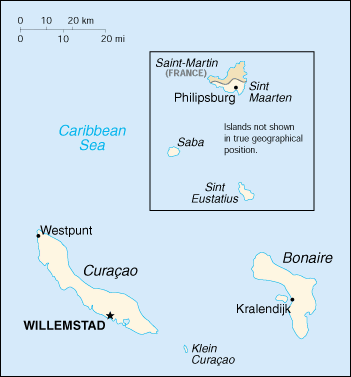Sint Eustatius
|
|

Sint Eustatius (also Saint Eustace and Statia), pop. 3,600, is one of the islands making up the Netherlands Antilles; it is in the northern, Leeward Islands portion of this territory, to the east of the Virgin Islands at Template:Coor dm. The regional capital is Oranjestad. It is named after the legendary Catholic saint Eustace.
History of Sint Eustatius
The island was seen by Christopher Columbus in 1493 and claimed by an astonishing welter of nations over the next 150 years. In 1636 it was colonized by the chamber of Zeeland of the Dutch West India Company. As of 1678 the islands Sint Eustatius, Sint Maarten and Saba fell under direct command of Dutch West India Company. At Sint Eustatius a commander was stationed, who also governed over the islands Sint Maarten and Saba. At the time, the island was of some importance for sugar cultivation.
In the 18th century the island became known as the Golden Rock, since the island's economy flourished by ignoring the trade embargoes between the great powers.
Since the island sold arms and ammunition to everyone who wanted to pay for it, the island was one of the few ways for the rebellious Thirteen colonies to obtain weaponary. This good relationship between Sint Eustatius and the United States resulted in the famous flag incident, when commander De Graaff of Sint Eustatius decided to answer the salute fire of the Andrew Doria that visited the island on 16 November 1776. The United States gave the answering salute great publicity since the island de facto recognized the independance of the United States.
The British didn't take the incident too serious however, although they remained protesting against the continuous trade between the United States and Sint Eustatius. In 1778 Lord Stormont claimed in British parliament that 'if Sint Eustatius had drown into sea three years before, the United Kingdom would already have dealt with George Washington'. The trade of Sint Eustatius with the United States was the main reason for the Fourth Anglo-Dutch war, which was disastrous for Dutch trading.
StEustatius.jpg
As a result of the war Sint Eustatius was taken by the British on 3 February 1781. Commander de Graaff, who at the moment was not informed about the declaration of war but saw that he was faced with a great supremacy, handed over command of the island to admiral Rodney. Ten months later the island was conquered by the France, allies of the Dutch in this war. The Dutch regained command over the island in 1784.
At its peak Sint Eustatius may have had a population of over 20,000 people. In the time since, this has gradually slumped to 3,600, and Sint Eustatius is eclipsed by Curašao and Sint Maarten.
Geography of Sint Eustatius
Geographically, the island is saddle-shaped, with the 602 meter-high Mount Mazinga (an extinct volcano) to the southeast and the smaller pair Signal Hill/Little Mountain and Boven Mountain to the northwest. Quill Crater on Mount Mazinga is a minor tourist destination. The bulk of the island's population lives in the "dip" between the two areas, which crosses the center of the island.
External link
- Map and info (http://www.lonelyplanet.com/mapshells/caribbean/sint_eustatius/sint_eustatius.htm)
Template:Maplrde:Sint Eustatius eo:Sint Eustatius et:Sint-Eustatius nl:Sint-Eustatius pt:Sint Eustatius tr:Ermiş Eustatius
